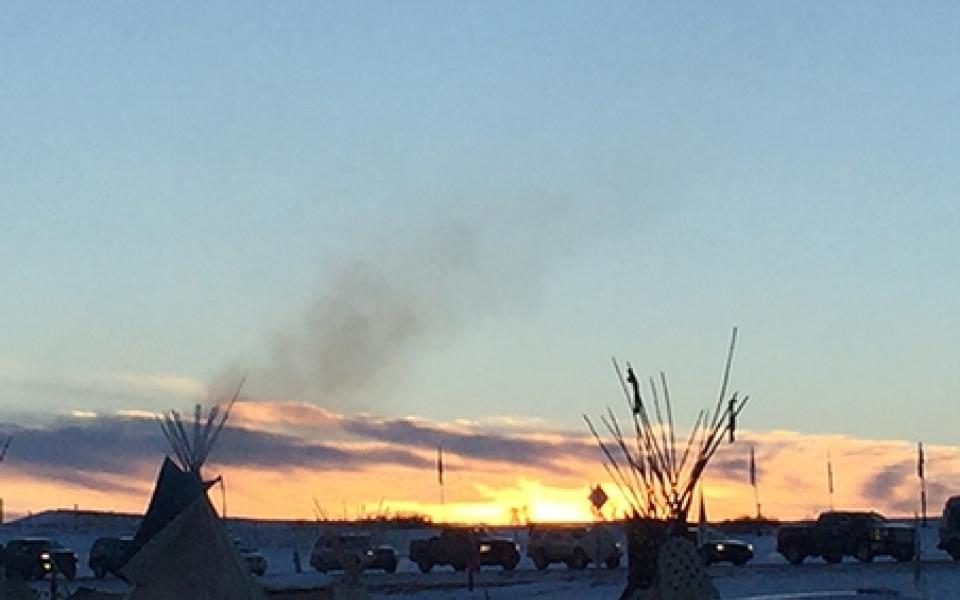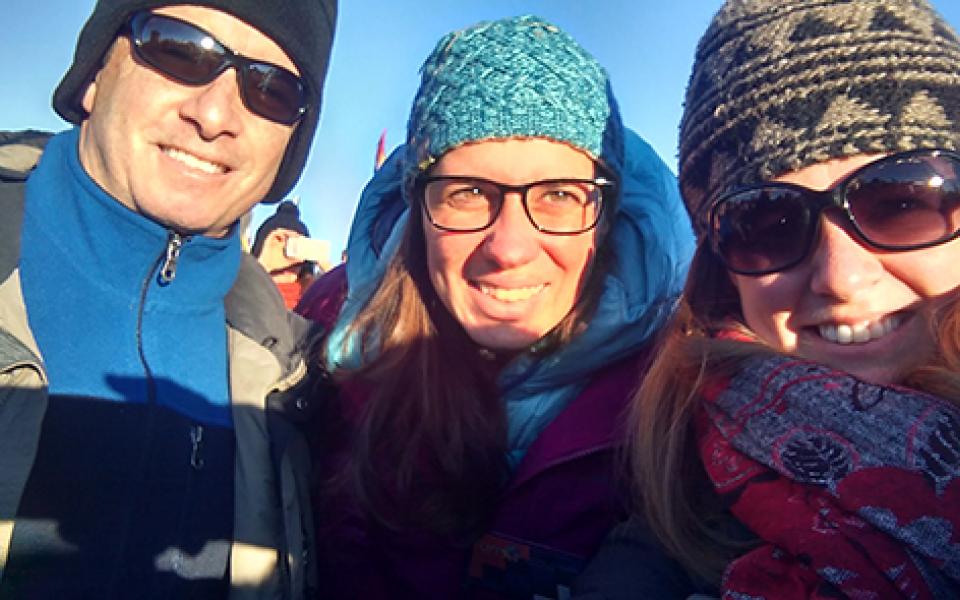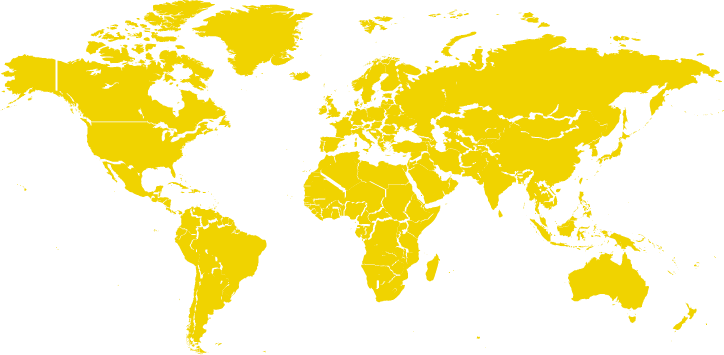
Oceti Sakowin Camp is a place of juxtapositions and marvels. Tribal leaders ceremonially sing and drum near the sacred fire while helicopters chop and drones buzz overhead. Ten thousand peaceful and prayerful water protectors abut a militarized police force of extractive corporation-protectors. And this past weekend thousands of combat veterans arrived at camp to defend with their bodies—for what some said felt like truly the first time—the American people.
This past weekend may prove to be pivotal, not just for Standing Rock but possibly for indigenous and environmental movements worldwide. But its success is all the more remarkable because the resistance was spiritual down to its sinews, channeling energies and mobilizing unseen forces that renders the whole thing a practical miracle.
“Mni wiconi!” “Agua es vida!” “Water is life!”
When tribal elders broke the news at camp on Sunday afternoon, the throngs of people around the sacred fire erupted. There were joyful whoops, tears, tight embraces. But my own joy was tempered with a dose of skepticism, which I suspect was felt tenfold by the people who have been systematically lied to and betrayed by the US federal government for centuries. Why now? To stymie the pubic awareness generated by 500 clergy and almost 5000 veterans who descended on camp that weekend? Would the delay tactic of an EIS prove to be enough to render the project economically infeasible? Can an easement permit denial be enough to halt the desperate pressure of DAPL? But confirmation from tribal leaders, who had personally communicated with federal officials, inspired confidence. “We won this battle but the war continues,” an elder announced over a megaphone. And indeed, the camp isn’t going anywhere. It is, after all, their land. And promises to native communities have a tendency to be broken.
Success
Yet the narrative emerging out of the camp this weekend is one of success. As I understand it, much was at stake for DAPL in completing the project by January 1, after which point the contract locking in 2014 oil prices must be renegotiated. Also an EIS, as opposed to an EIA, has a wider scope and can take years to complete, rendering the project economically unfeasible. From my experience organizing to block coal export terminals in the Pacific Northwest through Earth Ministry, this stall tactic can be very effective.
It’s worth reflecting on how this utterly unlikely and unprecedented victory occurred. Yes, organized nonviolent civil disobedience works. Yes, thousands of bodies coming together en masse, making a statement of solidarity through their physical presence matters. Yes, this unprecedented gathering of tribes and indigenous people captivated national and international media attention. But this victory is ultimately a spiritual one, a victory of the powerful force of prayer and energies in a way that has humbled cynics and convinced skeptics. Corey Danseraeu calls it a victory “on the level of biopower, the programming of the human being as chemical-physical-conscious dance of rituals, curations, carings, including of course the relation to nonhuman others like the Land and the Water.”
This powerful truth was epitomized for me in one moment, with two words.
It was in the pre-dawn hour of my first moment at camp, and the water blessing ceremony had just begun. I stood at the periphery of a wide circle around the sacred fire and listened to women chanting, drumming. Women quietly approached with pitchers of blessed water from the river and Dixie cups. Before long we made our way, hundreds strong, silent in the frigid morning darkness, shuffling along Flag Row to the edge of the Cannonball River. There the men and women separated, the men forming a double human railing down the icy embankment, and women passed carefully, single file, grasping the men’s hands, looking into each set of eyes, down to the river’s edge amidst soft murmurs of song and drumbeat. One by one we approached the frozen river and, with a prayer, placed tobacco into the river water through a hole in the ice.
As I approached the river, a grandmother’s voice pierced the quiet. “Pray hard!” she cried. It was a command, an admonition, and it jolted me out of my reverie. My prayer mattered here. It was expected, necessary that each prayer join the throngs lifting up their voices to God, gods, Spirit. And so I prayed like I haven't prayed in years, with a fervor reminiscent of my evangelical days, to a source that I no longer feel I can name or understand but is nevertheless fully present, perhaps nowhere more so for me than along that riverbank. In this community, prayer was resistance and resistance was prayer.
The compassionate spiritual force has extended to the police, pipeline workers and oil company executives, all of whom receive the prayers of the Water Protectors, as do their children and grandchildren. According to one water protector, almost 30 County Sheriff’s officers have turned in their badges since the beginning of the conflict, claiming that this is not what they signed up for. Several have come into the camp.
What now?
The ceremonial act of resistance that is Standing Rock is not over. The sound of hammers and saws rings throughout the camp as permanent structures go up on this reclaimed land, reclaiming the concept of eminent domain. Each port-a-potty in camp has a small purple flier taped to the door, listing the other sites of indigenous struggle against extractive industries. And powerful forces still want to build this pipeline
One of the many things I did not understand prior to my visit was the degree to which the struggle at Standing Rock is a struggle for a people’s very existence. More than respecting sacred burial grounds, more than combatting climate change, more than protecting the health of a community (although it is all those things)…. this is an effort to affirm nothing less than the very right of a people to exist. “Native erasure is ubiquitous, both cultural and literally, bit pushed from public view,” writes Kelly Hayes. “Our struggles intersect with numerous others, but are perpetuated with different motives and intentions… The violence against us has always had one pragmatic aim: our total erasure.”
So I bring this experience to my URI home, the Multiregion. We are poised for a thematic restructuring in 2017, ready to support and enhance and amplify the work of indigenous CCs throughout our network. How might be utilize the momentum of Standing Rock to empower indigenous interfaith movements around the world? Let’s envision, dream, work and struggle together.

Frederica Helmiere (center) with Global Council Trustee Fred Fielding and URI North America Regional Coordinator Sari Heidenreich
